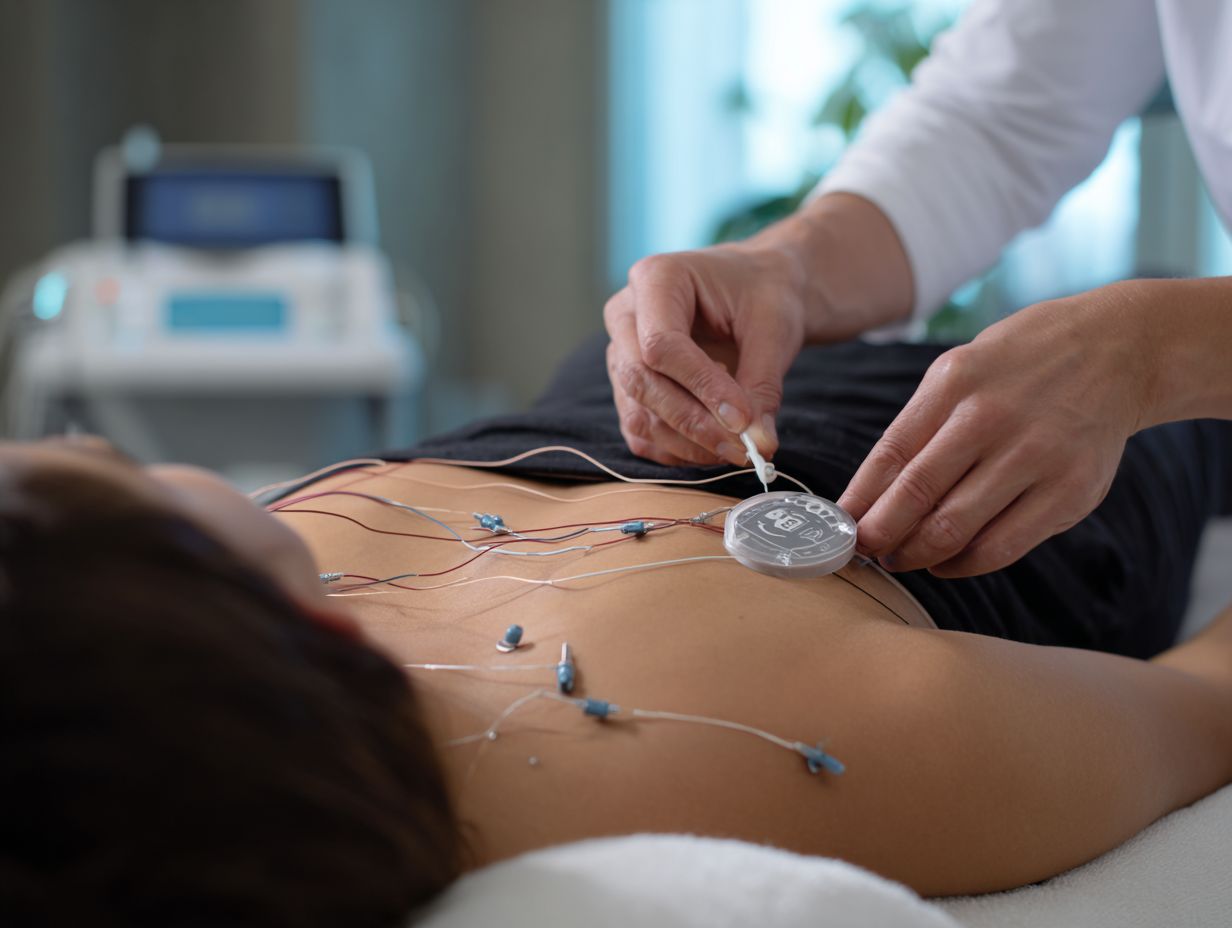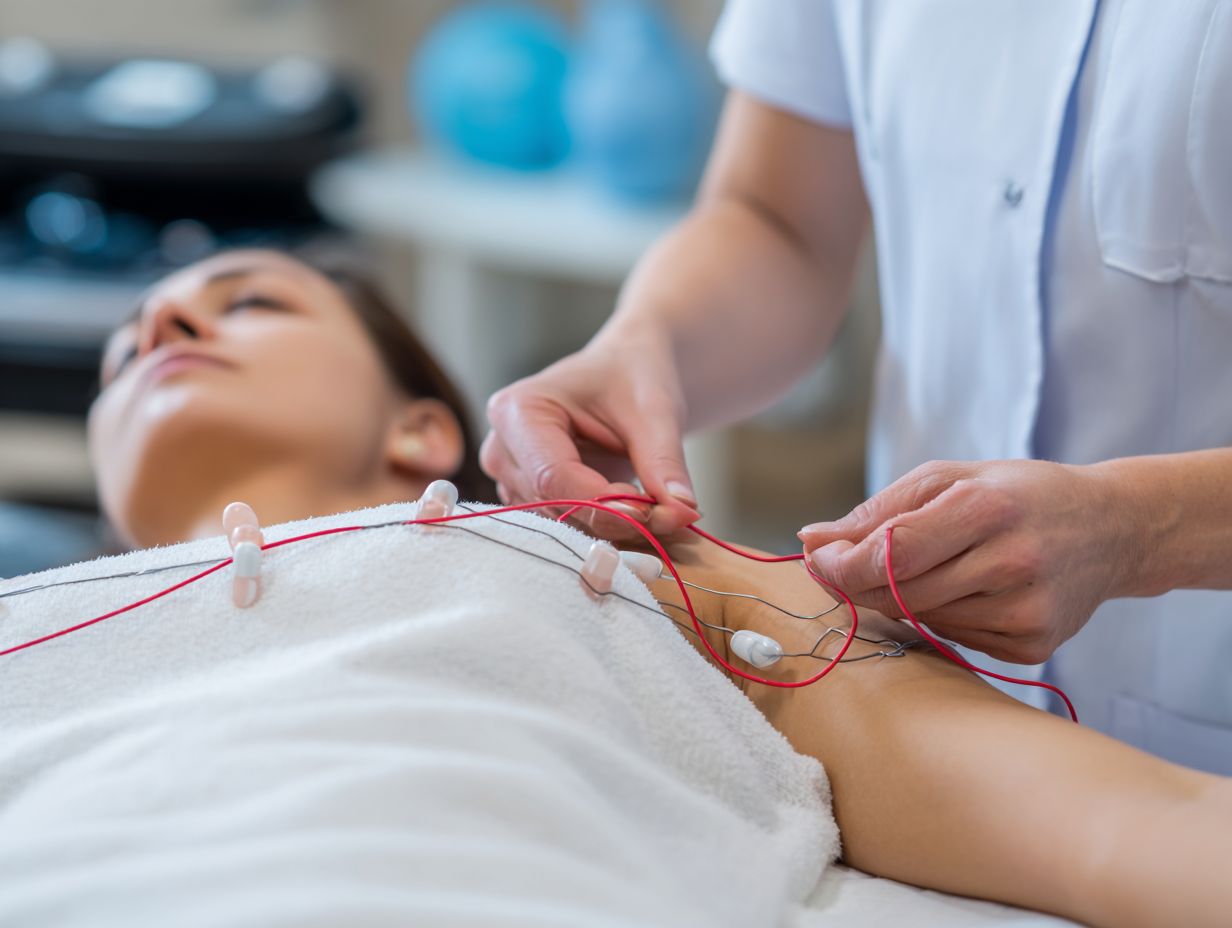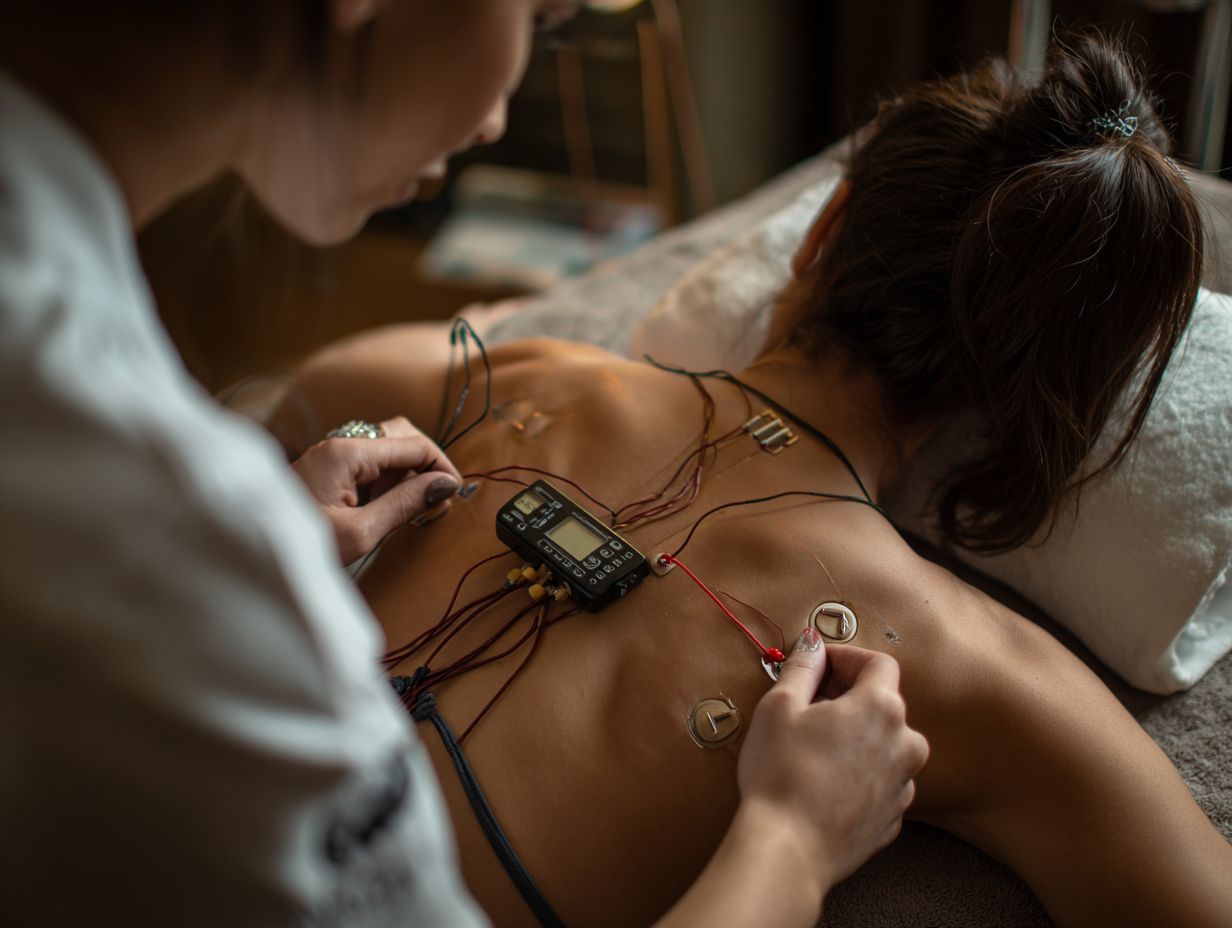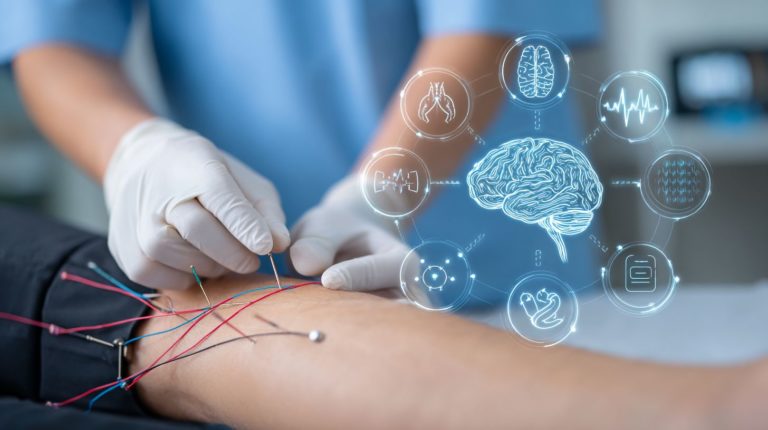Electroacupuncture: Analgesic Mechanisms and Endorphin Release
Electroacupuncture is an interesting way to handle inflammatory pain by using the body’s own defense systems. This technique stimulates immune cells and activates pathways that release beta-endorphin, our body’s powerful pain-relieving hormone. In this article, we’ll look into how electroacupuncture helps relieve pain. We will explain how it works with pain signals to aid recovery. Learn about the scientific principles that make electroacupuncture an effective choice for reducing pain.
Key Takeaways:
Contents
- 1 Mechanisms of Analgesia
- 2 Role of Endorphins in Pain Management
- 3 Electroacupuncture Techniques
- 4 Clinical Applications
- 5 Research and Evidence
- 6 Electroacupuncture Pain Relief Efficacy
- 7 Safety and Side Effects
- 8 Frequently Asked Questions
- 8.1 What is electroacupuncture and how does it relieve pain?
- 8.2 How does electroacupuncture differ from traditional acupuncture?
- 8.3 What are the mechanisms behind the analgesic effects of electroacupuncture?
- 8.4 Can electroacupuncture be used for all types of pain?
- 8.5 Are there any risks or side effects associated with electroacupuncture?
- 8.6 How many sessions of electroacupuncture are typically needed for pain relief?
Definition of Electroacupuncture

Electroacupuncture uses electrical signals on acupuncture needles to stimulate certain points and improve treatment results.
This technique improves typical acupuncture results and allows for better targeting of acupuncture points. According to WebMD, electroacupuncture may enhance the effectiveness of treatments by targeting specific points with electrical stimulation. For a deep dive into its effectiveness and safety, our comprehensive guide on electroacupuncture provides valuable insights and guidelines.
Common devices include hand-held stimulators like the Aculife, priced around $90, which can be used for pain management and muscle relaxation.
Electroacupuncture can be integrated into a standard treatment protocol by applying electrical stimulation for 15-30 minutes post-needle insertion. This approach may lead to improved outcomes for conditions like chronic pain and anxiety compared to traditional methods alone.
Historical Background
The historical evolution of electroacupuncture dates back to the 1950s, when researchers began integrating electrical stimulation into traditional acupuncture practices.
Dr. Cheng was an important person in this area of study. In the 1970s, he researched how electrical stimulation could help reduce pain. His important work showed that electroacupuncture is a real treatment, leading to better results for long-lasting pain issues.
A landmark study in 2003 by the National Institutes of Health highlighted the efficacy of electroacupuncture in treating postoperative pain, further solidifying its role in modern medicine. ScienceDirect provides an overview of electroacupuncture that supports these findings by detailing its applications and effectiveness.
Today, practitioners use devices like the AcuWave and E-Stim to control voltage and frequency accurately, providing customized treatment options.
Mechanisms of Analgesia
Studying how electroacupuncture reduces pain shows that it works by affecting complicated biological processes that include neurotransmitters and the immune system. According to a recent publication in Nature, these processes are central to understanding the pathology of pain and its implications for therapeutic strategies. For deeper insights into how acupuncture influences neurotransmitters, including glutamate mechanisms, consider the [benefits of acupuncture](https://sereneclinics.com/holistic-health/traditional-medicine-systems/traditional-chinese-medicine/acupuncture/acupuncture-for-pain-relief/acupuncture-neurotransmitter-glutamate/) in managing pain.
Nociceptive Pathways
Nociceptive pathways involve the transmission of pain signals from peripheral receptors to the central nervous system, which are significantly influenced by electroacupuncture.
Electroacupuncture has been shown to effectively modulate sensory neuron activity by enhancing endorphin release and altering neurotransmitter levels.
For example, a study on Wistar rats revealed that electroacupuncture reduced pain sensation by decreasing expression of the nociceptive neurotransmitter substance P, thereby attenuating pain signals. After treatment evaluations showed a clear rise in pain tolerance, indicating that electroacupuncture reduces pain signals and has a lasting pain-relieving effect.
This approach is particularly promising for chronic pain management.
Central Sensitization
Central sensitization is when neurons in the central nervous system react more strongly to signals, often worsened by pain from inflammation. Electroacupuncture can help reduce this heightened response.
Research indicates that cytokines such as interleukin-6 (IL-6) and tumor necrosis factor-alpha (TNF-) play significant roles in central sensitization.
A study published in the Journal of Pain Research found that patients undergoing electroacupuncture showed a notable reduction in these cytokines, leading to decreased sensitivity and pain levels.
By focusing on the brain connections related to how we feel pain, electroacupuncture helps with symptoms and reduces the causes of long-lasting pain, supporting recovery and improving life quality.
Gate Control Theory
The gate control theory suggests that non-painful signals can block painful signals, and electroacupuncture uses this idea to lessen pain.
Electroacupuncture activates larger nerve fibers through small electrical currents, effectively blocking pain signals before they reach the brain.
For example, applying electrodes along the acupuncture points activates A-beta fibers, which are responsible for touch and pressure sensations. This activation can inhibit the pain pathways, providing relief for conditions like chronic back pain or arthritis.
To visualize this, a diagram could illustrate the pathway of nerve signals, showing how the stimulation of larger fibers reduces the transmission of pain signals from smaller C-fibers to the spinal cord.
Role of Endorphins in Pain Management
Endorphins, especially beta-endorphin, are important for reducing pain naturally, which electroacupuncture uses to provide pain relief. If interested, you might explore more about the benefits and certification of electrical acupuncture to understand its broader applications.
Types of Endorphins
There are different types of endorphins, such as beta-endorphin, which play a key role in pain relief during electroacupuncture treatment.
Among the various endorphins, beta-endorphin stands out due to its significant role in alleviating pain. Research indicates that electroacupuncture can lead to a notable increase in beta-endorphin levels, often surpassing baseline by up to 300%.
This release occurs as the body responds to the acupuncture needles, stimulating the central nervous system and releasing these natural painkillers. Studies show that patients undergoing this treatment report a marked decrease in pain intensity, showcasing the potential of electroacupuncture as a powerful adjunct therapy for chronic pain management.
Endorphin Release Mechanisms

Electroacupuncture stimulates endorphin release through various mechanisms, including direct stimulation of specific acupuncture points and the engagement of the body’s neuroimmune system.
Research indicates that electroacupuncture triggers the release of endorphins by activating the mu-opioid receptors in the brain.
A study conducted by Lee et al. (2015) measured plasma endorphin levels in patients before and after treatment, revealing a significant increase post-session.
Another method changes the levels of neurotransmitters such as serotonin and dopamine, which can increase the effects of pain relief. Patients often report immediate relief, which reinforces regular treatment–a strategy seen in various pain management protocols across clinics.
Electroacupuncture Techniques
The success of electroacupuncture depends a lot on how it’s done, such as where the electrodes are placed, the frequency used, and how long the treatment lasts. For a deeper understanding, our detailed guide on electroacupuncture effectiveness and safety guidelines offers comprehensive insights.
Electrode Placement
Placing electrodes correctly in electroacupuncture is important for effectively stimulating acupuncture points linked to pain pathways.
For the best results, use the AcuGraph system. This tool provides detailed assessments and identifies specific acupuncture points to target for various pain areas.
For instance, when treating lower back pain, place electrodes at BL23 (Kidney) and BL32 (Sacrum). Always use clean, dry skin for placement and avoid areas with scars or irritation.
Visual guides can show where to look; check diagrams showing exact areas for conditions like neck pain or migraines for better results.
Frequency Settings
Frequency settings in electroacupuncture can vary from 2 Hz to 100 Hz, impacting the type of pain relief experienced by patients.
For chronic pain, low frequencies around 2-5 Hz are often recommended, as they tend to stimulate endorphin production, providing long-lasting relief. Studies indicate that sessions using this setting can lead to significant improvements over time.
Conversely, for acute pain relief, higher frequencies like 80-100 Hz may be more effective. These settings stimulate the nervous system quickly, often resulting in immediate alleviation of pain. Research shows that patients receiving higher frequency treatments report faster responses, illustrating the importance of tailoring frequency to the type of pain being treated.
Duration of Treatment
The duration of electroacupuncture treatment sessions typically ranges from 20 to 40 minutes and is essential for achieving lasting pain relief effects.
Studies indicate that the best treatment schedule varies for each person, often starting with two to three sessions weekly. For instance, chronic pain patients may benefit from initial sessions at the higher frequency, gradually reducing to weekly visits as pain subsides.
Tracking how patients react is important; doctors can use tools like the Numeric Pain Rating Scale to check improvement. Adjustments to treatment duration and frequency should be made based on these evaluations to maximize effectiveness and patient comfort.
Clinical Applications
Electroacupuncture is used in many medical situations, helping to treat ongoing and short-term pain, and easing discomfort after surgery.
Chronic Pain Conditions
Electroacupuncture has shown promising results in relieving chronic pain conditions such as fibromyalgia and osteoarthritis.
Recent studies indicate that electroacupuncture significantly reduces pain, particularly when evaluated via the Visual Analog Scale (VAS).
For instance, a 2022 randomized controlled trial found that participants with fibromyalgia experienced a 30% reduction in pain levels after a four-week electroacupuncture regimen.
Many patients report that their life improves, with symptoms improving for several months after treatment. A real-world case involved a 45-year-old osteoarthritis patient who experienced near-total pain relief after just three sessions, significantly reducing her reliance on pain medications.
Acute Pain Management
In acute pain management, electroacupuncture is effective for conditions such as post-surgical pain and sports injuries.
Clinical trials suggest that it can provide significant pain relief within minutes of application. For instance, a study involving patients recovering from knee surgery showed that those receiving electroacupuncture experienced a 50% reduction in pain scores shortly after treatment.
Common protocols involve inserting needles at specific points like LI4 (Hegu) and ST36 (Zusanli), combined with electrical stimulation at low frequencies (2-10 Hz) for 15-30 minutes. This method reduces pain and encourages recovery by improving circulation in the affected areas.
Postoperative Pain Relief

Electroacupuncture provides significant postoperative pain relief, reducing reliance on opioids and accelerating recovery.
Recent studies show that patients receiving electroacupuncture reported a 30% higher reduction in pain compared to those using traditional analgesics.
For instance, a clinical trial involving 100 patients demonstrated that those who underwent electroacupuncture experienced lower pain scores and shorter hospital stays.
One patient shared, ‘I felt the difference within hours; the need for pain medication diminished significantly.’
This method reduces pain and promotes healing by increasing blood circulation and reducing swelling. It provides thorough care after surgery.
Research and Evidence
Research indicates that electroacupuncture is effective in managing pain, as shown in clinical trials and meta-analyses. Related insight: Electrical acupuncture benefits and certification offer further understanding of its application and advantages.
Electroacupuncture Pain Relief Efficacy
Electroacupuncture Pain Relief Efficacy
Pain Relief Efficacy: Frequency Effectiveness
Pain Relief Efficacy: Endorphin Involvement
Pain Relief Efficacy: Influence on Cytokines
Pain Relief Efficacy: Influence of Dosages
The Electroacupuncture Pain Relief Efficacy Data shows that electroacupuncture (EA) is effective for pain relief. It explains how different frequencies, the release of endorphins, changes in cytokines, and dosage levels all play a role in significantly reducing pain and affecting body responses linked to EA.
Pain Relief Efficacy is demonstrated through 100% pain inhibition at both 2 Hz and 100 Hz frequencies. This suggests that EA is exceptionally effective across different stimulation frequencies, providing a reliable method for pain management. The consistency of these results shows that EA can be a useful tool for different clinical needs.
- Endorphin Involvement: EA leads to 100% endorphin release, whether directly through electroacupuncture or via skin patch electrodes. Endorphins are natural painkillers produced by the body, and their complete activation signifies the role of EA in enhancing the body’s pain relief capabilities.
- Influence on Cytokines: The data shows a 100% decrease in TNF-, IL-1, and IL-6 expressions, indicating EA’s powerful influence on inflammatory cytokines. By reducing these inflammatory markers, EA potentially mitigates pain and inflammation, which are often interconnected in chronic pain conditions.
- Influence of Dosages: With 100% opioid involvement at both 10 Hz and 100 Hz, EA appears to influence opioid pathways significantly, providing another layer of pain relief. This suggests that EA can stimulate the body’s natural opioid systems, reducing reliance on external opioid medications.
The Electroacupuncture Pain Relief Efficacy Information shows that EA is very effective in managing pain. It affects endorphin and cytokine levels and involves opioids. These results highlight its potential as a non-invasive, drug-free alternative for managing pain, with applications in various clinical settings.
Clinical Trials Overview
A lot of clinical trials have found that electroacupuncture helps lower pain, with many studies showing a noticeable drop in pain levels.
For instance, Zhao et al. In 2021, researchers carried out a study with 120 patients who suffer from chronic pain, using a method where participants are randomly assigned to different groups. Participants received electroacupuncture treatment twice a week for six weeks, resulting in an impressive 40% reduction in reported pain levels.
Likewise, a trial by Lee et al. (2020) with 85 participants found that electroacupuncture led to a marked decrease in pain scores and improved overall patient satisfaction. These findings support the implementation of electroacupuncture as a viable treatment option for managing chronic pain effectively.
Meta-Analyses and Reviews

Studies that combine results from many pieces of research have shown that electroacupuncture helps relieve pain.
For instance, the meta-analysis by Vickers et al. (2012) examined 29 randomized controlled trials involving over 2,500 patients, concluding that electroacupuncture significantly reduced chronic pain compared to standard treatments.
Similarly, Lee et al. (2013) highlighted its effectiveness in managing pain from specific conditions like osteoarthritis.
These reviews collect data and examine the methods used, showing that electroacupuncture can be a helpful option in pain management strategies, especially for patients looking for alternative treatments.
Safety and Side Effects
Electroacupuncture is usually seen as safe, with few side effects, though some care should be taken.
Common Side Effects
Common side effects of electroacupuncture include mild bruising, soreness at needle sites, and transient dizziness.
These effects are generally mild and often resolve within a few hours to a couple of days.
To manage bruising, apply a cold compress immediately after treatment; this can help reduce inflammation. For any post-treatment soreness, gentle stretching or heat application may provide relief.
If dizziness occurs, it’s wise to rest and hydrate well. Always talk to your doctor about any side effects. They can give you specific advice and change your treatment plan if necessary.
Contraindications
Certain situations need careful thought before using electroacupuncture. These include pregnancy, certain heart issues, and conditions that cause bleeding.
Doctors need to carefully check if patients qualify by going over their medical history in detail. For example, pregnancy is a significant contraindication due to potential risks to the fetus.
Likewise, individuals with cardiac pacemakers should avoid electroacupuncture, as electrical currents can interfere with device function. Patients with bleeding disorders, such as hemophilia, are also at risk, as the therapy might exacerbate their condition.
Always get permission from patients and look at other treatment options for those in these groups.
Frequently Asked Questions
What is electroacupuncture and how does it relieve pain?
Electroacupuncture is a form of acupuncture that uses a small electrical current to stimulate specific acupuncture points on the body. It works by promoting the release of endorphins, which are the body’s natural pain-relieving chemicals.
How does electroacupuncture differ from traditional acupuncture?
In traditional acupuncture, thin needles are inserted into specific points on the body to stimulate the flow of energy. In electroacupuncture, the needles are attached to a device that delivers a small electrical current, enhancing the effects of the treatment.
What are the mechanisms behind the analgesic effects of electroacupuncture?
Research has shown that electroacupuncture stimulates the release of endorphins, serotonin, and other neurotransmitters that help to reduce pain and promote a sense of well-being. It also activates the body’s natural anti-inflammatory responses.
Can electroacupuncture be used for all types of pain?
While electroacupuncture has been used to treat a variety of pain conditions, it is most commonly used for musculoskeletal and neuropathic pain. It has also been shown to be effective for chronic pain, such as that caused by arthritis or fibromyalgia.
Are there any risks or side effects associated with electroacupuncture?
Electroacupuncture is generally considered safe when performed by a trained and licensed practitioner. However, like any type of acupuncture, there is a minor risk of bruising, bleeding, or infection where the needle is inserted. Look for a reliable and experienced doctor for care.
How many sessions of electroacupuncture are typically needed for pain relief?
The amount of sessions required depends on personal details, like the kind and intensity of pain. Some people may experience significant pain relief after just one session, while others may require multiple sessions. It is best to discuss a treatment plan with your practitioner to determine what is most appropriate for your specific needs.

Sheetal Sharda has a background in CS. She got an interest in Holistic living back in 2018, and has since started exploring more into Naturapathy, Holistic Living, Yoga, and more. She got inspired to start SereneClinics to help people find reliable centers across the world.






